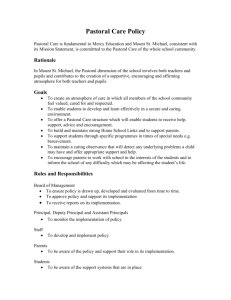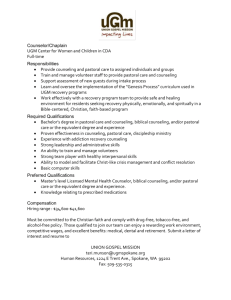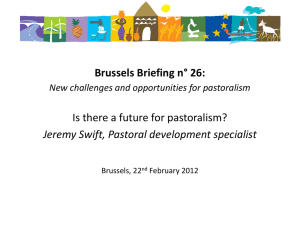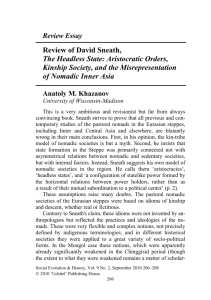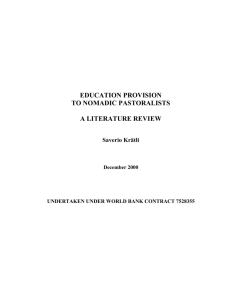File
advertisement
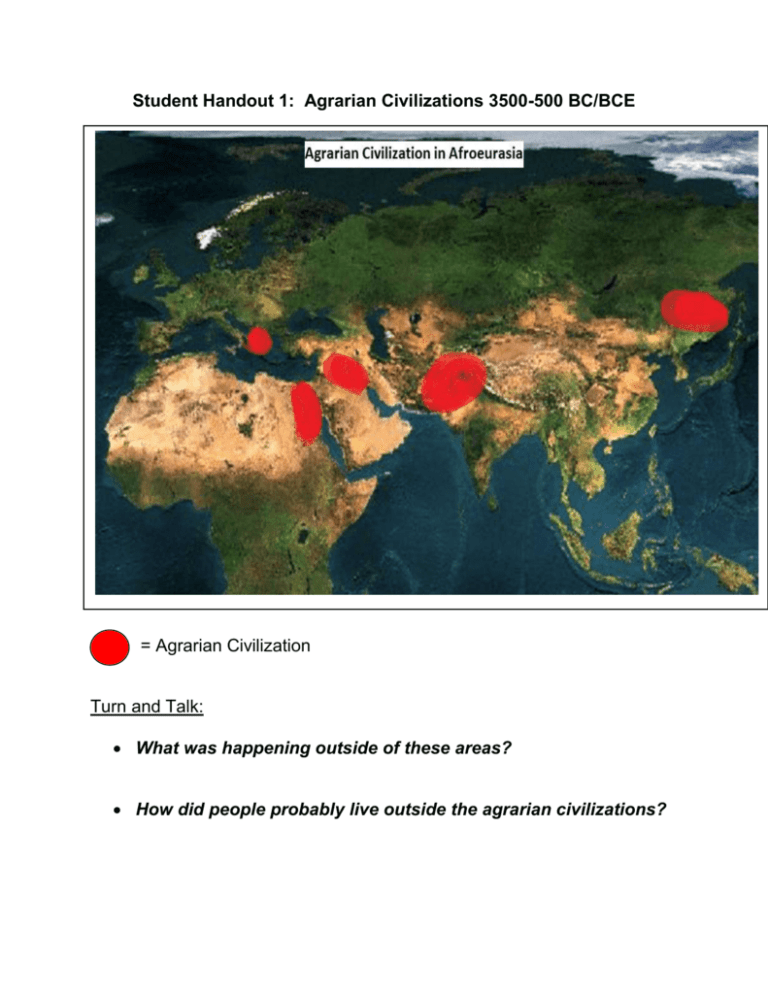
Student Handout 1: Agrarian Civilizations 3500-500 BC/BCE = Agrarian Civilization Turn and Talk: What was happening outside of these areas? How did people probably live outside the agrarian civilizations? Student Handout 2- Animal-Herding Societies Animal-herding societies. From about the fourth millennium BCE (4000 BCE), Afroeurasia saw the development of a new type of society and economy in parts of the Great Arid Zone. This is the belt of dry and semiarid land that extends across Afroeurasia from the Sahara Desert in the west to Manchuria in northern China. Great Arid Zone Here, communities began to organize themselves around a specialized way of life based on herding domesticated animals, like sheep, cattle, horses, or camels. Known as pastoral nomadism, this economic system permitted humans to adapt in larger numbers than ever before to climates where intensive farming was not possible. Pastoral nomads lived mainly on the products of their livestock—meat, milk, blood, hides, hair, wool, and bone. They often grazed and migrated over extensive areas, and they only planted crops either as a minor, supplemental activity, or not at all. Stop and Jot: Why didn’t nomadic pastoralists settle down and farm where they were? (This is an inferential question... you need to use information in the text to make your best guess!) By the third millennium BCE (3000 BCE), animal-breeding societies were appearing in a number of regions, notably along the margins of the Great Arid Zone. These communities found they could adapt to dry conditions because sheep, cattle, and a few other domesticated animals could thrive on wild grasses and shrubs. These animals converted vegetable matter that humans could not digest into meat, milk, and blood, which they could. Stop and Jot: Why did humans need these animals to survive on the margins of the Great Arid Zone? What was this area like and what did animals do to help humans survive? Pastoral communities usually followed regular migratory routes from pasture to pasture as the seasons changed. When families were on the move, they lived in hide tents or other movable dwellings, and their belongings had to be limited to what they could carry along. This does not mean that they wished to cut themselves off from farming societies or cities. Rather, pastoralists eagerly traded with people from farming societies. In doing so, they obtained farm produce or other items in exchange for their hides, wool, and dairy products. Sometimes pastoralists even traded their services -- as soldiers and bodyguards for farming communities. Thus the ecological borders between pastoral societies and town-building populations were usually scenes of lively trade. Because pastoral societies were mobile, and not permanently settled, the way they expressed social relationships differed. Instead of referring to people by where they lived, pastoral nomads expressed social relationships in terms of kinship --that is, who was related by “blood” to whom—closely, distantly, or not at all. Turn and Talk: Why did pastoralists move so regularly and how did they interact with agrarian communities in this process? “Migrations and Militarism across Afroeurasia, 2000-1000 BC/BCE.” World History for Us All. San Diego State University. 21 April 2012 <http://worldhistoryforusall.sdsu.edu/units/three/landscape/03_landscape4.pdf >. Student Handout 3 – Large Mammals and Nomadic Pastoralists Horses: The horse is often the animal most beloved by the nomadic people. The horses of Central Asia have been known for their stamina, strength, speed, and endurance since ancient times. They are adapted to the extremes of weather and terrain of this region, making them valuable forms of transportation. The mane and tail are used for making rope, weaving, and even musical instruments. Horses are not generally raised for food or hides, though they may be utilized for meat or leather. The milk of mares is made into a fermented beverage by some groups of nomadic herdsman. The famous horses of Ferghana were especially valued and used as tribute to the Chinese emperors. The Khans used the small and seemingly tireless Mongolian ponies as they began their quest across the continent to establish the Mongol Empire. Sheep: The staple livestock of the nomadic people, sheep are valued for their milk (used to make dairy products) and mutton (meat from an adult sheep which was a basic part of their diet). The sheep's wool adapts it to the environment in terms of its texture and length. The wool is used for felt, carpets, and clothing. The hide is also valued for leather products. Sheep require protection from predators, as well as fresh pasturelands. Goats: The goat is valued by Central Asian nomads for their meat, milk, hide, and particularly wool. As with sheep, these products are important in providing food, clothing, and products to sell. In some areas of Central Asia, the production of cashmere has become an especially profitable product of this animal. These animals are also adapted to the mountainous terrain of Central Asia. Camels: The sturdy, steady camel is an important livestock commodity as transportation. In an arid region, this animal can survive for up to a month without fresh water. The camel is especially helpful as a beast of burden in the desert areas, with feet, hides, and eyes particularly adapted to this environment. In addition, the milk, meat, and wool of camels are also important to the people who raise them. It was the domestication of the camel that made travel along the Silk Road possible for the purposes of trade. Bovines: (Cows/Yak/Ox) The shaggy yak is the animal of high altitudes. Cross breeding with cattle has produced a domestic ox that is a valued animal in parts of Central Asia. The domestic yak of today provides milk and meat, which is consumed fresh or dried. Hides are used for leather, and hair is used for rope and cloth. The yak is also utilized as a beast of burden and transportation as they are well adapted for their high altitude environment, much as camels are used in the desert. The less sturdy cow is found in flatter elevations and used for milk, meat, and leather, though it is not used for transportation and carrying things. Dogs: The only non-livestock animal that is frequently found among the nomadic people of Central Asia, the dog is used to guard livestock and property. Dogs keep predators such as wolves at bay and may be used for hunting. They are not considered pets, though they are admired for their loyalty and valued for their courage. Source: http://www.nationalgeographic.com/xpeditions/lessons/12/g68/animalnomadstudent.pdf Group Discussion Questions – Information to present to the class: How common is this animal in our society? Why? What role does it play? How is it utilized? What qualities would we use to describe this animal? Do you think the use of this animal has changed through our history? How? Why? Why might this animal be especially valuable to a nomadic pastoralist? Student Handout 4 - Descriptions of Nomadic Peoples in the Written Record Document 1: Pastoralism in China, 100 BC/BCE Document 2: Mesopotamia, From a poet’s tale of the marriage between the Goddess Innana and the God Damuzi (2nd Millennium BC/BCE) Document 3: During the second millennia BC/BCE, a pastoral group from InnerEurasia (see Map II), invaded the Indus River Valley. They brought with them a language known as Sanskrit part of a larger language family known as Indo-European, the same language family that English and other European languages developed from. They also brought with them prayers and hymns priests would chant before battle. After they had settled down and developed their own form of writing, these hymns were written down in a book called the Rigveda. 1. His face is like a thundercloud, when the armored warrior goes into the lap of battles. Conquer with an unwounded body; let the power of the armor keep you safe. [He is calling for protection by the metal and leather armor he wears and by the sacred power of the hymn.] 2. With the bow let us win cows, with the bow let us win the contest and violent battles with the bow. The bow ruins the enemies’ pleasure. 3. She [the bow] comes all the way up to your ear like a woman who wishes to say something, embracing her dear friend; humming like a woman, the bowstring stretched tight on the bow carriers you safely across in the battle. . . . 4. These two who go forward like a woman going to an encounter hold the arrow in their lap as a mother holds a son. Let the two bow-tips, working together, pierce our enemies and scatter our foes. 5. Standing in the chariot, the skillful charioteer drives his prize-winning horses forward wherever he wishes to go. Praise the power of the reins: the guides follow the mind that is behind them. 6. Neighing violently, the horses with their showering hoofs outstrip everyone with their chariots. Trampling down the foes with the tips of their hoofs, they destroy their enemies without veering away. . . . 7. Her [the arrow’s] robe is an eagle, and her tooth is a deer; bound with cows, she flies as she is sent forward. Let the arrows give us shelter wherever men run together and run separately. [The arrow is robed with eagle feathers, tipped with deer-horn and bound with leather thongs.] 8. Spare us, O weapon flying true to its mark; let our body be stone. . . . 9. He beats them on the back and strikes them on the haunches. O whip the horses, drive forward into battle the horses who sense what is ahead. . . . 10. Whoever would harm us, whether it be one of our own people, or a stranger, or someone from far away, let all the gods ruin him. My inner armor is prayer. Source: http://worldhistoryforusall.sdsu.edu/units/three/landscape/03_landscape4.pdf Document 4: “Pastoral Nomadic groups thought of themselves as blood brothers, committed to live and die for their tribe. Their society was patriarchal, and men owned the herds. These cowboys of the ancient world loved riding and racing horses, hunting, wrestling, and archery. Warfare was even more important for pastoral nomads than it had been for earlier pastoralists because of rising population and more competition for grazing land. Nomads had to be ready to fight at a moment’s notice.” --Jean Elliott Johnson and Donald James Johnson (2000) The Human Drama, p. 85. Student Handout 5: Pastoral Nomads: Adaptations and Interactions Pastoral nomads are animal-herding people who migrate seasonally in search of grazing land for their livestock. Pastoral nomadic groups became significant on the stage of Afroeurasian history in the second millennium BCE. Adaptations: Like hunting, pastoralism offered a technological solution to the ecological problems that the harsh environment of Inner Eurasia posed. Its success encouraged population growth, and as populations grew, Inner Eurasian communities faced new challenges. They had to find ways to mobilize scarce resources both to sustain themselves and to defend themselves against rival groups. The relatively flat landscape of Inner Eurasia offered a few natural resistances. Where geography offered no shield, societies had to rely on tactical and fighting skills. Stop and Jot after reading the paragraph and studying both maps: Why was farming not an option for people living in Inner Eurasia? Why was pastoral nomadism more practical? Why were pastoralist societies so warlike? The pastoral way of life favored warrior cultures. Livestock was a less secure resource than agricultural crops. Disease could swiftly destroy a large herd, and rival nomad rustlers might steal an entire herd. Herders had to be able to react quickly in a crisis. Controlling large animals also required the physical skills of a rodeo rider and the logistical skill of a cattle driver. This means that they had to have a system of military readiness both to protect their animals and to raid their neighbors. It requires physical strength, endurance, and a great tolerance for hardship. Turn and Talk: What was difficult about living as a pastoralist and taking care of herds of animals? How did people adapt to these difficulties? Pastoral societies had to be able to transform themselves easily into armies capable of fighting with skill, spirit, and ferocity. Military resources had to be concentrated in relatively sparse populations. Therefore, training in how to ride and shoot had to begin at an early age. The pastoral nomadic way of life also encouraged aggression and a willingness to resort to violence, a limited empathy for other peoples’ suffering, restrained affections in personal relationships, and great concern for personal courage and status. Pastoral societies instilled these martial values in both women and men. Stop and Jot: How did people adapt to the specific challenges of being a nomadic pastoralist? What values, attitudes, and skills did they have to develop to survive and succeed? Interactions: Contacts with farming societies of Outer Eurasia may have created new opportunities for trade and raiding. With the rise of chariot warfare in the second millennium BCE, empires such as those of China and Assyria needed horses for their armies. Since they didn’t have the land needed to support large herds, they had to import horses from the steppes. Pastoralists of Inner Eurasia could maintain large herds only if they took up a nomadic lifestyle. If this argument is correct, it suggests the beginning of an interdependent relationship between Inner and Outer Eurasia. Pastoral nomads frequently moved with their livestock herds through regular yearly circuits to find fresh water and pastures. Nomads depended for survival on the meat and milk of their flocks, as well as other resources like hides (skin) and bone, but they still needed some agricultural products, such as grain. As a result, pastoral nomadic societies relied on farming societies for certain products. Pastoral nomads usually needed the grains and luxury products of agricultural societies more than farmers needed surplus livestock. This unbalanced relationship helps explain why relations between nomads and settled peoples sometimes became violent, especially along the borderlands between Inner and Outer Eurasia. Turn and Talk: What did farmers and pastoralists need from each other? Why did this matter? What was the impact of their dependence on each other and their interactions?
